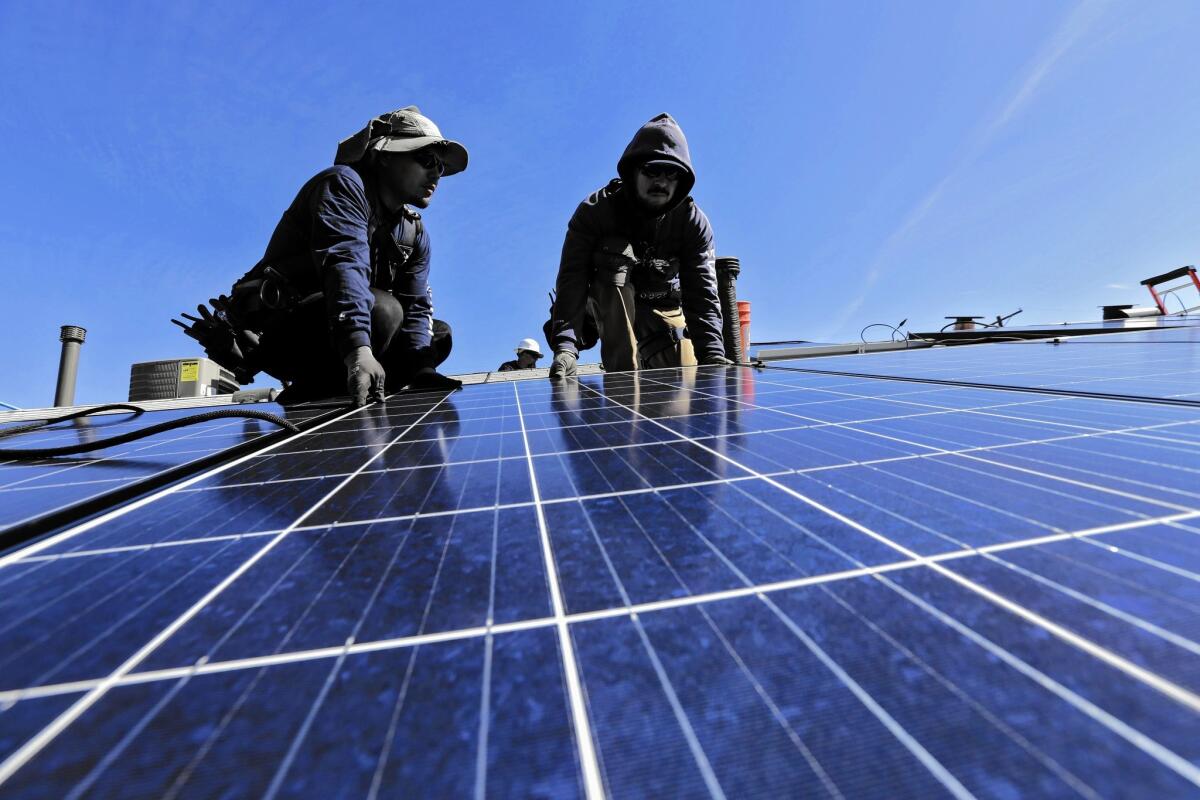Are you paying too much for a rooftop solar system?

- Share via
If you’re thinking about pulling the trigger on a rooftop residential solar system, don’t be afraid to drive a hard bargain with an installer.
“There’s so much competition, there’s no reason not to get better deals,” said Ryan Willemsen, founder and chief executive of the start-up Solar to the People.
Based in San Diego, Solar to the People just released a study detailing the costs of residential solar in 12 regions across California.
For purchases, Los Angeles/Ventura counties came in fourth at $18,040. San Diego finished in sixth place — in the middle of the study’s rankings — with an average cost of $18,540. Orange County finished seventh at $18,866.
The Central Coast region came in with the lowest average cost in the state at $16,212 and the Redding and Shasta/Cascades area had the highest at $20,698.
Willemsen said the best way to determine a good deal is to look at the cost per kilowatt because it gives consumers a chance to evaluate the amount of energy production they’re getting per dollar.
“That allows for an apples to apples comparison of bids across installers, because installers almost never propose the exact same size systems,” Willemsen said.
By that measure, Redding and Shasta/Cascades turned in the lowest average, at $3,178 after incentives.
The state average per kilowatt was $3,395. Los Angeles and Ventura counties averaged $3,537. Orange County averaged $3,430. San Diego averaged $3,378.
One of the biggest problems right now in the market is, there’s a lot of confusion.
— Ryan Willemsen, founder and chief executive of Solar to the People
“The California solar market is more mature and competitive than other states like New York,” Willemsen said.
The Solar for the People study of installation costs did not include savings that solar customers can get through net metering or the costs to lease a system.
“The company [that leases an installation] owns the panels and vacuums so they set up a monthly payment with the consumer that can be fluctuating,” Willemsen said. “It’s actually pretty complicated.”
The Solar to the People study covered systems that are bought either with loans or cash.
Thousands of homeowners have taken advantage of the California Solar Initiative, which offered cash back for solar installations for homes and businesses.
But the rebates for residential customers of San Diego Gas and Electric and Southern California Edison have been tapped out.
On the federal level, Congress last December extended federal investment tax credits for solar installations for five years.
Consumers get 30% off the costs, but the tax credits are scheduled to go down to 26% in 2020, then drop to 22% by 2021 and eventually fall to 10%.
Free-market advocates have long criticized federal and state subsidies for renewable energy, but Willemsen said the scheduled phase-out won’t deliver a death blow to the solar industry, especially in California.
“It’s valid to say solar should stand on its own merits. But that being said, the prices are going down so rapidly that by the time the federal incentives are phased out, solar will be standing on its own,” Willemsen said. “Solar has gone over the hump.”
In existence for one year, Solar to the People makes its money by offering potential customers multiple quotes from its network of installers, who then pay the company for referring them to residential projects.
Just as companies like Edmunds.com help prospective car buyers negotiate the best deal and sites like Expedia and Kayak help people find the least expensive flights and hotels, Solar for the People is trying to do the same thing for those thinking about installing solar but are hesitant to pull the trigger.
“One of the biggest problems right now in the market is, there’s a lot of confusion,” Willemsen said. “People don’t understand what the costs legitimately are.... There are a lot of installers that push for a one-product solution and some of them are giving the industry a bad name. We want to encourage comparison shopping.”
rob.nikolewski@sduniontribune.com
Twitter: @robnikolewski
ALSO
A guide to drawing down your savings in retirement
What it’s like to live in a city with a $14 minimum wage
Jennifer Febre Boase is brewing up beer and career in Van Nuys
More to Read
Inside the business of entertainment
The Wide Shot brings you news, analysis and insights on everything from streaming wars to production — and what it all means for the future.
You may occasionally receive promotional content from the Los Angeles Times.










